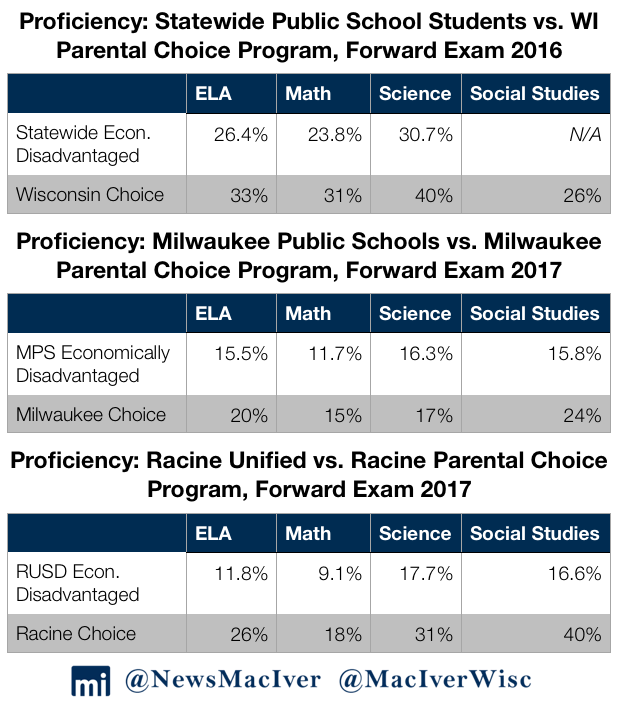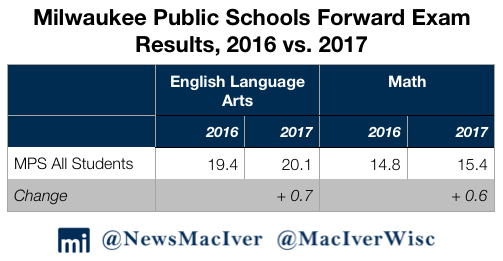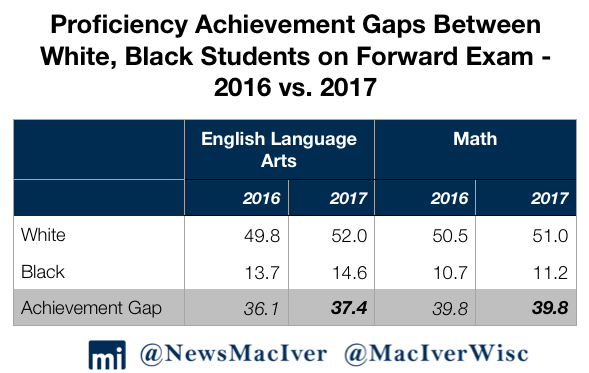
Students saw small increases in proficiency on the Forward Exam, but decreases on ACT Plus Writing Exam
MacIver News Service | September 28, 2017
By Ola Lisowski
[Madison, Wis…] A new data release from Wisconsin’s Department of Public Instruction shows that 44.4 percent of 3rd to 8th grade students are proficient in English language arts, and 42.8 percent are proficient in math. The results are slightly better than last year’s outcomes, which showed that 42.7 percent of students are proficient in English, while 42.5 fared the same in math.The results come from the Forward Exam, administered during the 2016-17 school year. This is the second straight year of the Forward Exam which is important because it is the first time in many years we can directly compare test results to the prior year.

Students fared slightly worse than the year prior in both science and social studies. Fewer than 50 percent of students scored proficient in both subjects.
School Choice Students Do Better In Every Category
Students enrolled in Wisconsin’s parental choice programs outperformed their public school peers in every category.
When compared to similar MPS students, parental choice students did much better. Students in all three major parental choice programs – statewide, Milwaukee, and Racine – outperformed their peers in every single subject on the Forward exam. On the ACT, choice students fared better than even their full-income peers.
Jim Bender, President of School Choice Wisconsin, celebrated the results.
“All three Parental Choice Programs, comprised predominately of low-income students, outscored their full-income, public school counterparts across the entire state on the ACT for the second year in a row. Combined with the Forward Exam, these results highlight the continued success of the program,” Bender said.
In its press release, DPI compared all public school students to choice students – but this is a flawed comparison. Given the income limitations for entrance into the school choice programs, much larger percentages of those students are economically disadvantaged. As a result, it is more accurate to compare choice school students with economically disadvantaged public school students.
State Superintendent Tony Evers focused on the overall positive aspects of the data release.
“We’re seeing some positive student gains in the Forward Exam in English language arts,” Evers said. “Our educators and students are growing more comfortable with the test and have begun to use the information it provides to drive student improvement.”
While the results were in general worrisome, students at a few of the state’s most troubled districts showed small but promising growth. At Milwaukee Public Schools (MPS), 20.1 percent of students were proficient in English language arts, compared to 19.4 percent the year before. In math, 15.4 percent of students were proficient, up from 14.8 percent.

Those are small improvements, but improvements nonetheless. The math achievement gap among black and white students at MPS shrank slightly, from a 29.3 point gap last year to a 28.9 gap today. Still, just 8.4 percent of black students were proficient in math. The troubled district continues to underserve its students.

Statewide,the achievement gap between white and black students grew in English language arts and stayed stagnant in math. As Wisconsin’s minority population grows, achievement gaps between white and historically underserved populations will continue to be a big issue. Students, and schools, have their work cut out for them.
ACT Plus Writing
On the ACT Plus Writing exam, results were more clearly negative. While nearly 2.75 percent more students took the exam, they also fared worse in every subject compared to the prior year. In the 2015-16 school year, students scored an average composite score of 20.1 out of 36 on the ACT Plus Writing. A year later, the average composite score was a 20.0.
The scores are gleaned from students who participated in the Spring statewide ACT administration. This was the second year that the state picked up the tab to allow all high schoolers to take the ACT.
The average English language arts score fell from 18.6 to 18.3, while the average math score fell from 20.1 to 20.0. Students scored the highest average score on science at 20.4, down from 20.5 last year.
The ACT also includes its own benchmarks for proficiency which aim to translate the composite score into levels of readiness for college. Those benchmarks show that 39.3 percent of students scored proficient in English language arts, while 31.5 percent were proficient in science.
Perhaps the single bright spot in the entire ACT release – other than the increase in student participation – was that the percent of students proficient in math grew slightly. While the overall math score had fallen, 35.4 percent of test takers were dubbed proficient, up from 34.8 percent the prior year.
That a mere 0.6 percent increase in proficiency in a single subject was the highlight in this data release shows just how serious the situation is. Students in minority groups, as well as English learners and economically disadvantaged students fared consistently worse on this year’s ACT compared to last year. Among black students, the average composite score was just 15.5 of 36, compared to 15.8 last year.
The same day as Wisconsin’s data release, another study showed strong results for students who participated in Florida’s tax credit scholarship program. Individuals who received that scholarship – known as the country’s largest private school choice program – were shown to attend college and attain degrees at higher rates.
The longer that students participated in Florida’s school choice program, the better their outcomes were. The scholarship increased college attendance among recipients by an average of 15 percent compared to public school peers. Students who participated in the school choice program for more than four years saw a 43 percent increase of college attendance compared to their peers.
In a statement to MacIver News, Bender said that the findings “mirrored those from Milwaukee.”
“Higher graduation rates, college acceptance and college retention rates were all identified for the Milwaukee Parental Choice Program,” Bender said. “Hopefully, education policy will focus on replicating the success in Florida and create more pathways for success.”
The data comes just over a month ahead of the release of Wisconsin’s new school report cards, which are expected in November.
